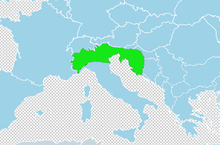Salmo marmoratus
| Salmo marmoratus | |
|---|---|
 |
|
| Scientific classification | |
| Kingdom: | Animalia |
| Phylum: | Chordata |
| Class: | Actinopterygii |
| Order: | Salmoniformes |
| Family: | Salmonidae |
| Genus: | Salmo |
| Species: | S. marmoratus |
| Binomial name | |
|
Salmo marmoratus G. Cuvier, 1829 |
|
 |
|
Marble trout (Salmo marmoratus) is a species freshwater fish in the Salmonidae family. It is characterized by distinctive marbled color pattern and high growth capacity. The marble trout is found in only three basins and two rivers of the Adriatic basin, namely the Po with only northern/left tributaries and the Adige, Brenta, Piave, Tagliamento and Livenza basins in Italy, the Soča basin in Slovenia and Italy, the Neretva river in Bosnia and Herzegovina and Croatia, and the Morača river in Montenegro. While once present in the Drin river basin in Albania fish is almost certainly extirpated there.
The marble trout has a long, cylindrical body, slightly compressed laterally, with a large head (22-25% of the body length) which is why it is also known as "Glavatica" ("glava" - head) in Bosnia and Herzegovina. The most obvious characteristic of marble trout is of course the marble pattern. The intensity of colour varies considerably upon the surroundings. Some marble trout have red spots that merge with the rest of the pigment, always only along the lateral line.
Its average size is 30–70 cm. The largest specimen in Slovenia was a 117 cm and 24 kg female (found dead), largest living specimen caught was 120 cm and 22.5 kg. There are reports of individuals weighing up to 30 kg. The largest specimens were found in Bosnia and Herzegovina, inhabiting the Neretva river from below town of Konjic downstream to town of Čapljina, mostly in canyon section from town of Jablanica to city of Mostar, and later after construction of Jablanica dam on the Neretva river in Jablaničko Lake.Trout become sexually mature at the age 3+ years (males) and 4+ years (females), they spawn during November and December.
...
Wikipedia

